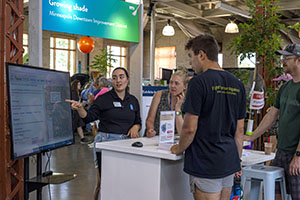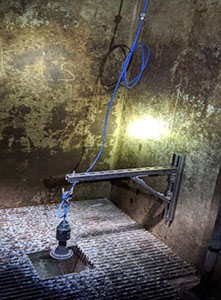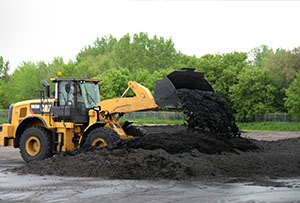Local Partnerships

We work closely with local communities to improve quality of life, including water quality monitoring and odor control initiatives. We are committed to transparency with our customers, making important information easily accessible. And through our wide-ranging involvement in surface water and water supply planning and assessment, we are in a unique position to provide a regional perspective on water issues.
“Major wastewater conveyance projects rarely attract public attention, and yet they are vital to protect the health and welfare of the public and surrounding environment. This was a great project from start to finish with its detailed design, innovative construction techniques, and community and agency engagement.”
— Sarah Lloyd, chair of the association’s Minnesota Awards Committee
Minnehaha Park Area project receives Public Works Project of the Year Award
Each year the American Public Works Association (APWA) recognizes the efforts of public works agencies, contractors, and consultants who develop, own, and maintain infrastructure projects that promote excellence in construction management and administration.
In 2022, the Minnehaha Park Area Regional Sewer Improvements project received APWA’s Public Works Project of the Year Award (for projects of $5 million but less than $25 million) in the Environment category. Environmental Services used innovative construction management techniques to rehabilitate the 80-year-old non-circular sewer located 75 feet below ground. The project required extensive collaboration and coordination among numerous local and regional agencies and took place during the peak of the COVID-19 pandemic. Despite these challenges, the project was completed on schedule and on budget.
 Flow meter upgrades maximize accuracy and reduce maintenance
Flow meter upgrades maximize accuracy and reduce maintenance
A cross-functional effort to replace 16 magnetic wastewater flow meters and 170 meter level sensors significantly reduced the time spent on preventative maintenance in 2022.
There are 229 flow meters playing an integral role in the ES interceptor system, which also includes 640 miles of sewers, 60 lift stations, and 24 rain gauges. The flow meters detect the amount of wastewater flow in our system, which is used to determine billing rates to our customers, so accuracy is essential. The project was completed 6 months ahead of schedule in late 2021, and we have already seen measurable results. For example, corrective action “bad flow check” visits decreased by 90% following the installation of the highly accurate radar sensors.
By reducing the average time spent repairing and restoring damaged equipment, these positive outcomes allowed staff more time to focus on other projects.
Responding to the U of M emergency using coordinated collaboration
Two sewer system incidents prompted evacuations at the University of Minnesota's Minneapolis campus and in surrounding neighborhoods in summer 2022. They provided stark reminders of the importance of our work in regulating and monitoring our regional sewer system.
On June 30, an explosion occurred in the sewer system on campus. On August 2, a large oily substance was observed in the sewers near the university along with hazardous lower explosive limit readings. These incidents required a large coordinated interagency response. We worked with the Minnesota Pollution Control Agency, CenterPoint Energy, the Minneapolis Fire Department, Minneapolis Public Works, Minneapolis/UMN Police, and the Minnesota Department of Public Safety, as well as establishing alert protocols with the Saint Paul Fire Department and Saint Paul Public Works.
On August 9, a discharge was observed, and Environmental Services staff expertly traced the source back to a permitted industry. That company agreed to stop its discharge and entered into a stipulation agreement with requirements that needed to be met before it could resume discharging. The company was also issued a Notice of Violation and assessed cost recovery fees. We worked with the company to implement improvements in their processes, procedures, and monitoring to protect public safety.
 Empire Plant biosolids land application program partners with farmers to increase yields
Empire Plant biosolids land application program partners with farmers to increase yields
For almost 40 years, the Empire Plant has been processing biosolids that local farmers can use to improve soil health and promote plant growth. Biosolids, resulting from wastewater solids processing, are a renewable resource containing carbon, nitrogen, phosphorus, and other key nutrients that plants need for growth. Land application services are free to farmers.
To continuously improve the program, the ES land application team works closely with farmers to learn how we can better meet their needs. In 2022, we adjusted the method and frequency of the land application to adjust to farmer feedback and avoid soil compaction. We reached out to home and business owners about the land application happening in their area and educated the public about the nature and benefits of biosolids.
Farmer feedback about the program is overwhelmingly positive, citing increased yields, reduced costs, and increased efficiency. “I consider your product to be highly recyclable,” said Mike Conzemuis, a Dakota County farmer. “I think it’s a good product that should be utilized for the greater good of society— it just makes total sense for me.”
Capital Program begins dialogue with tribal nations
Due to the nature of wastewater collection and treatment, at times Environmental Services project sites come into proximity of waterways and landforms that are culturally significant to tribal communities.
In 2022, the Capital Program Team began an annual Environmental Services Capital Program Tribal Relations series with 11 federally recognized tribes in Minnesota. These meetings share information about the Environmental Services division and review details of capital program projects. We hope these meetings will help us build collaborative relationships with tribal nations and open discussions with tribal members about possible ways to avoid, minimize, or mitigate potential undesirable impacts of our current and future projects.